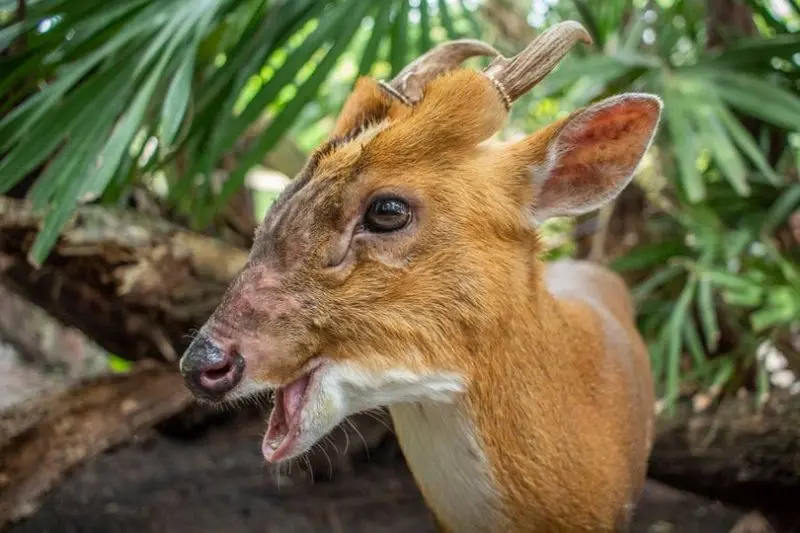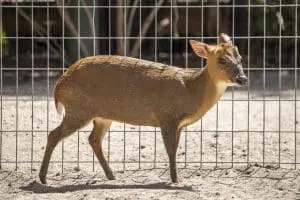

Kirby, our male Reeve’s muntjac, has some pretty unique features.
If you’ve visited the Brevard Zoo, you’ve likely met a lot of our more than 900 animal residents. Some animals are easy to spot, but others are often not as easy to see because of their habitat setup, their personalities, their sleep cycles, and other reasons.
That’s why we have a “Meet the Animals” section of our blog: to introduce you to some of the residents you may not have met yet – and might have difficulty meeting even if you intently looked for them!
Let’s be honest: The unofficial stars of our Lands of Change loop are our kangaroo mob members. With all the buzz around Lilly’s new joey and adorable antics from Hope, it can be easy to overlook some of our other animal residents who call the Kangaroo Walkabout home. However, next time you see a flash of brown run past you on the sandy trail, we can assure you it wasn’t your imagination. It’s likely one of our two Reeve’s muntjacs, Harriet or Kirby! With their shy personalities and slight stature, they often go unnoticed by the average zoo-goer.
What are muntjacs, you wonder? Well, you have come to the right blog post! Muntjacs, also known as the barking deer due to their warning call or mating sound, are a type of small deer known for some unique features. One of these unmissable qualities is the “holes” near their eyes called preorbital scent glands.
Lands of Change keeper, Alyssa Padmos, notes that these glands are primarily for conversing with other deer. They can reveal varied information to others by being licked, rubbed on objects, or even while using the restroom. These signals may pertain to territory, reproductive preparedness, personal identification, or the presence of a predator nearby. The males are also known for their fangs, which are used for defense purposes, and their stumpy antlers that shed annually. These traits have been a trademark of the species since prehistoric times, as they are considered to be one of the oldest species of deer.

Harriet and Kirby, since meeting, have become inseparable.
Alyssa describes both deer as “charismatic individuals once you get to know them.” They can be a bit timid, but their curiosity often gets the best of them. “Kirby has been known to have an affinity towards one of the male emus, Pedro,” added Alyssa. If you’re lucky, you might even catch the two resting together.
For any big-time muntjac fans out there, you’ll be happy to know that Harriet and Kirby are being paired to breed, as per the recommendation of the Association of Zoos and Aquariums’ Species Survival Plan (SSP), a program that ensures healthy, genetically diverse animal populations in AZA-accredited facilities. While this species of muntjac is not specifically endangered, breeding them can help increase the population’s genetic diversity and encourage people to learn more about muntjac conservation efforts.
Alyssa says, “When Harriet came to us this past Spring, Kirby was immediately smitten. They have been inseparable since day one!”
While Harriet is not yet pregnant, our keepers have been preparing for the possibility of a new fawn by tracking Harriet’s behaviors and training her for voluntary ultrasounds. We try to give our animal residents choice and control in all they do. Through training and getting them used to medical procedures like ultrasounds, animal care teams can monitor a resident’s health without using more invasive procedures. Keepers have plans in place in case of a muntjac pregnancy, including creating a quiet cozy space in the side yard where she can give birth in privacy and comfort.
Now that you’ve discovered a new favorite species to seek out at our Zoo, you might be deer-termined to observe these two’s antics. However, this may be a bit difficult since, like other deer, Harriet and Kirby are crepuscular. This means that these two are most active at dawn and dusk. However, when food is involved, nap time is abandoned for a quick snack. Peanuts are a favorite of Harriet’s, and Kirby likes sneaking some bites of the kangaroo’s corn.
We’ll keep our hooves crossed for a new fawn in 2024!
Brevard Zoo is an independent, not-for-profit organization that receives no recurring government funding for our operating costs. Your generous support enables us to continue to serve our community and continue our vital animal wellness, education and conservation programs.